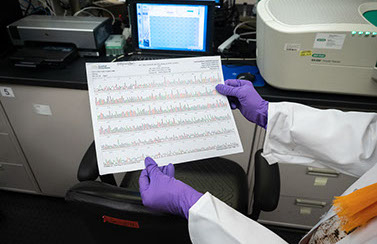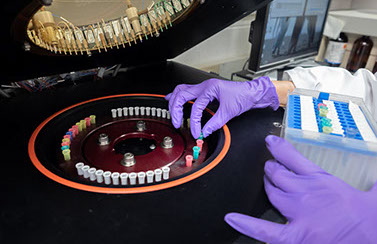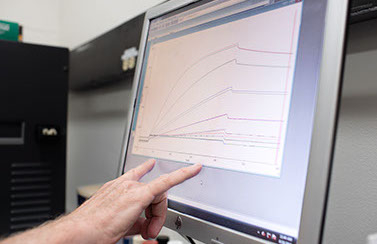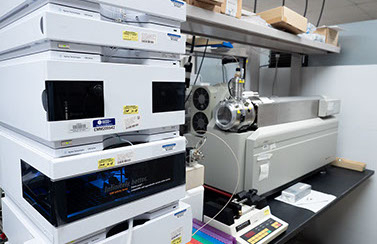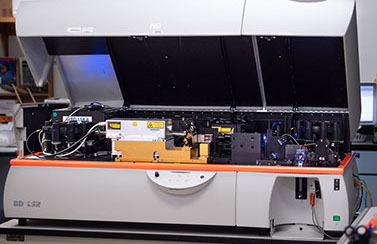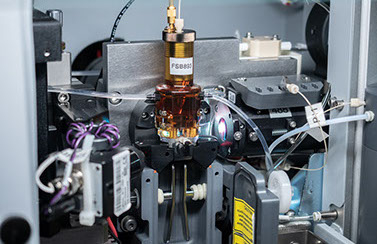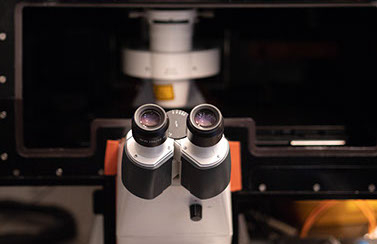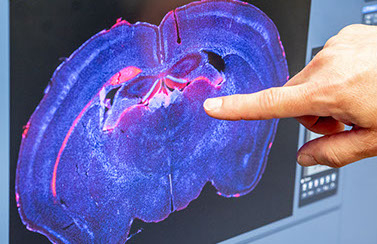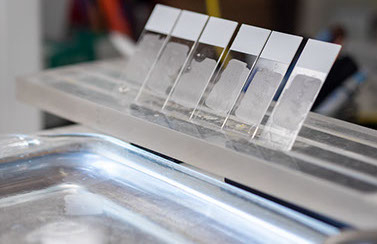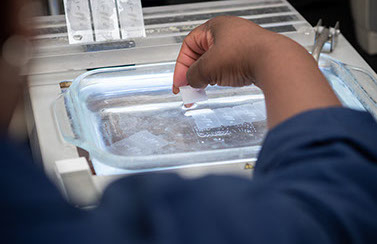RESEARCH SUPPORT RESOURCE FACILITIES
Students and faculty at USU are equipped with a vast array of robust resources for conducting research through the Office of Technological Research and Innovation (TRI). These support services include advanced biomedical research instrumentation, technical support with research repositories, animal care services, and technology transfer support.
BIOMEDICAL INSTRUMENTATION CENTER
The Biomedical Instrumentation Center (BIC) is an efficient, responsive, state-of-the-art core facility that supports teaching and research needs in the areas of flow cytometry, imaging, structural biology, histopathology, and genomics. These instruments include several cutting-edge microscope systems, state of the art flow cytometry cell analyzers, DNA synthesizers and sequencers, a vast array of methods to study biomolecules, and the latest instrumentation for histology. Staffed by skilled scientists and technicians, BIC supports the research of several departments throughout USU and has facilitated countless research protocols and publications.
BIC TECHNOLOGY
BIC consists of 5 Cores with state-of -the-art technology that supports teaching and research needs throughout the university.
Genetics Core Facility
- Gene-Forge 3900 and Applied Biosystems 3900: Two DNA synthesizers, each capable of producing 48 oligos in one run. These synthesize primers from 20 bases up to 100 bases long for use in cloning, mutation detection and gene expression experiments.
- ABI 3500xl Genetic Analyzer – Capable of high sensitivity analysis of oligonucleotide sequences for use in clone screening, genotyping, inheritable disease, mutation detection, and protein expression experiments.
- Bio-Rad QX200 Digital Droplet PCR system – Provides absolute quantification of target single DNA or RNA molecules with capacity to partition each sample at least 20,000- fold. Its applications include, but are not limited to, rare DNA target identification and quantification, pathogen detection, absolute quantification of sequencing libraries, digital gene expression analysis, genotyping and copy number variation detection, next generation sequencing (NGS), and single cell mRNA analysis.
- Roche LightCycler 480 – A high-throughput real-time PCR system for gene scanning assay, gene expression detection and genotyping.
- Agilent 1200 HPLC – Used in conjunction with DNA synthesis to ensure the quality of oligonucleotides and to purify the DNA as needed for special applications.
- U-3000 Thermo Fisher Scientific HPLC – Used in conjunction with DNA synthesis to ensure the quality of oligonucleotides and to purify the DNA as needed for special applications.
Structural Biology/Proteomics
- AB Sciex 4000 QTRAP Mass Spectrometer – identification and quantitation of low molecular weight proteins and lipids from mixed samples.
- Agilent 1200 HPLC –used in conjunction with the QTRAP to separate proteins from a mixed sample.
- GE Healthcare Biacore 3000 Surface Plasmon Resonance instrument – for measuring kinetic rate constants (association and dissociation) and binding affinities for biomolecular interactions.
- Wyatt Technologies Dynamic Light Scattering (DLS) instrument – for determining the aggregation state (monomer, dimer, multimer, aggregates) of solutions of biomolecules.
- Virtis Lyophilizer – for freeze drying biological samples (purified proteins, culture media (w/ excreted metabolizes/molecules of interest), etc.).
- JanSci Fluorescence Microscope – for identifying crystals containing proteins via tryptophan emission.
- Crystallization Robot – for assaying multiple crystallization conditions in order to identify optimum conditions for crystal growth.
Flow Cytometry
- Two BD LSRII Flow Cytometers – multi‐parameter analysis of cells and microscopic particles to determine cell phenotype, DNA content, and biochemical properties.
- BD FACSAriaII – multi‐parameter cell separation to isolate populations of interest for immunology and neuroscience applications.
Microscopic Imaging
- Luminex 100 – Performs multianalyte bioassay detection for immunology and molecular biology applications.
- Zeiss 710 Inverted Multiphoton Confocal Laser Microscope with Becker & Hickl FLIM Attachment – Capable of precision imaging of fluorescently labeled live and fixed cells for a wide variety of scientific applications.
- Zeiss AxioExaminer.Z1 Upright Multi‐photon Confocal Laser Microscope with Electrophysiology System – Precision imaging and electrochemical analysis of live cells and tissues.
- Zeiss AxioImager.M2 Upright Epifluorescent Microscope with MBF Stereology System – Performs precise quantitation of fixed cells in tissue sections.
- JEOL JEM 1011 Transmission Electron Microscope (TEM): Precision imaging of unstained cells and tissues.
- Leica UC6 Ultramicrotome with FC6 Cryo Attachment: used in conjunction with Transmission Electron Microscope to obtain high‐ quality tissue sections.
- Zeiss Pascal Inverted Confocal Laser Microscope ‐ precision imaging of fluorescently labeled live and fixed cells.
- Lica AF6000 Time‐Lapse Imaging System – precision imaging of bright field or fluorescently‐ labeled live cells.
- Zeiss Lightsheet Z.1- A Unique multiview light sheet fluorescence microscope that delivers optical sections of large samples, with virtually no phototoxicity or bleaching and with high temporal resolution.
Histopathology
- Leica Autostainer XL – Provides reproducible, consistent, high-quality automated chemical staining of fixed tissue samples.
- Leica CV5030 Robotic Coverslipper – Generates histology slides and used in conjunction with Leica Autostainer XL.
- Sakura Tissue‐Tek VIP Tissue Processor and Sakura Tissue‐Tek TEC Tissue Embedder – Performs automated processing and paraffin embedding of fixed tissue samples.
- Leica CM3050 S Cryostat – Performs precision tissue cryosectioning for biomedical, neuro-anatomical and pharmaceutical research
- Microm HM325 Microtome – Cuts high quality sections from paraffin‐embedded tissue samples.
- Hamamatsu NanoZoomer‐RS Digital Slide Scanner - Obtains high-resolution bright field and fluorescent digital scans of histology slides
THE AMERICAN GENOME CENTER
The American Genome Center (TAGC) is located at USU on the Walter Reed National Military Medical Center (WRNMMC) campus and one of only four academic genome centers in the United States. It is the Department of Defense operations subsidiary of the Collaborative Health Initiative Research Program (CHIRP) established between the National Heart, Lung, and Blood Institute (NHLBI) and USU. Since inception, TAGC has generated 40,000 whole Genome Sequences across 107 research studies sourced from NHLBI, other NIH Institutes, DoD and USU investigators. TAGC is also the sequencing center and genome data analysis center for the APOLLO Cancer Moonshot project, and collaborates for this purpose with the Murtha Cancer Center (MCC) at Walter Reed, the National Cancer Institute, and the Veterans Administration.
More About TAGC >
DEPARTMENT OF LABORATORY ANIMAL RESOURCES
The Department for Laboratory Animal Resources (DLAR), accredited by the Association for the Assessment and Accreditation of Laboratory Animal Care (AAALAC), is dedicated to supporting successful research and education for USU. Our commitment to excellent animal care and welfare is accomplished through regulatory compliance, veterinary medicine, animal husbandry, surgical support, procurement, and protocol consultation services.
4D BIO³
The 4-Dimensional Bioprinting, Biofabrication, and Biomanufacturing (4D Bio³) Program promotes the development and application of advanced bioprinting, biofabrication, and biomanufacturing technologies. 4D Bio³ includes a 4,000 ft²multi-tool facility includes a biofabrication suite, tissue culture room, bioreactor and sensor facility, and medical/surgical simulation room. The lab’s capabilities allow for military medical applications and translations to the fields of precision medicine, biomarker discovery, drug and vaccine development, medical technology validation, bio-sensors, environmental and occupational health, and regenerative medicine.

